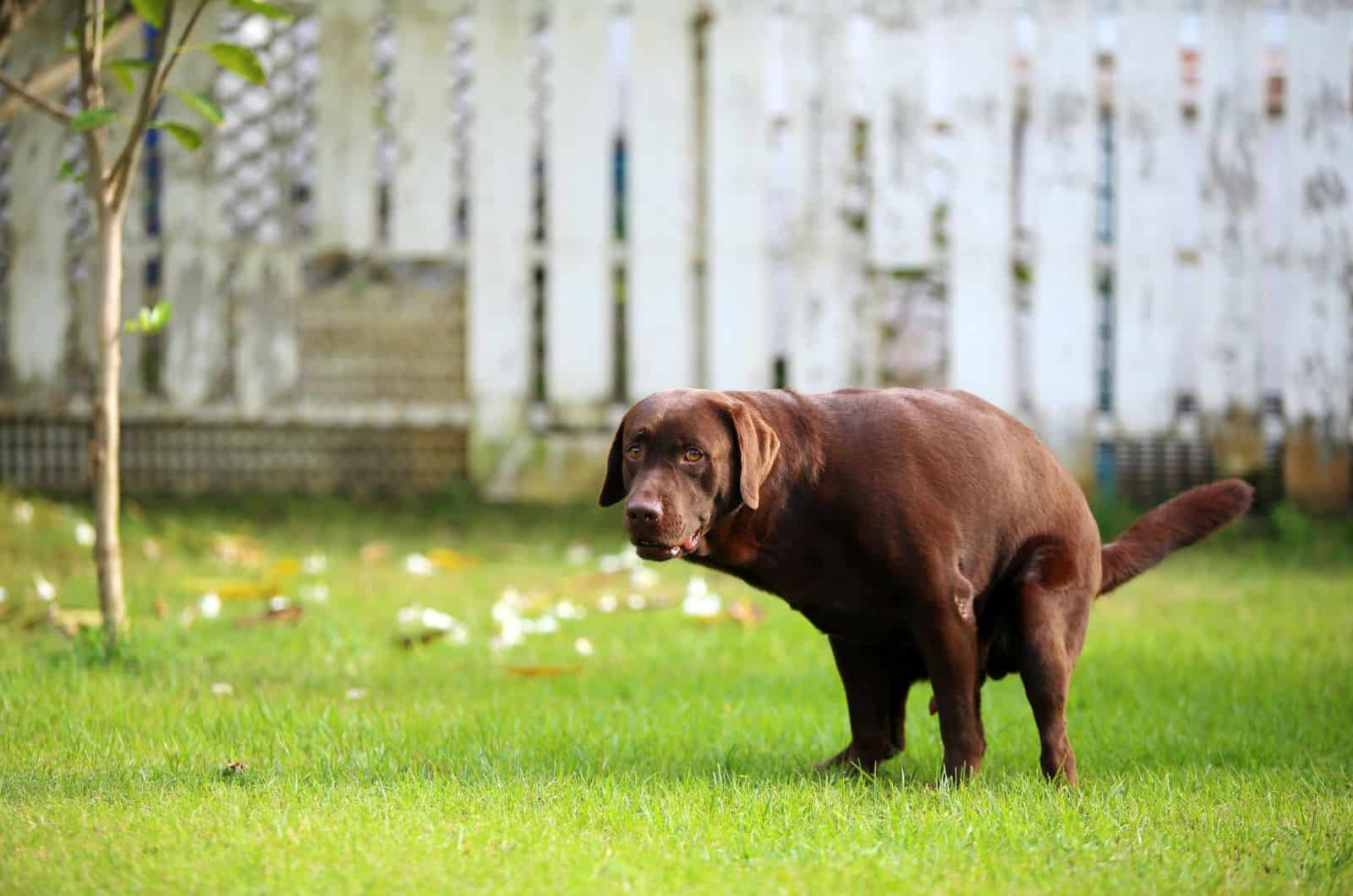In this article, we are going to spin the dog poop color wheel to show you a one-of-a-kind dog poop color chart!
The color of dog poop will vary depending on the food the dog is eating. This means that dog poop color can range from shades of green, yellow, orange, brown to black.
Due to the fact that poop color greatly reflects the health of your dog, we’re going to show you a detailed dog poop color chart.
Your dog’s health can be interpreted through this dog poop color chart. You can determine whether or not it is necessary to take your dog to the vet by understanding what each hue of dog feces implies.
The chart below is a dog poop color chart that can help you determine the poop color of your dog, what it means, and when to take action.
Dog Poop Color Chart Review
Are you ready to become a turd nerd and show off your dog poop knowledge to your friends? This dog poop color chart is written in a simple manner to help dog owners quickly memorize its contents.
In this dog poop color chart, we are going to show you ten different colors of dog poop. Additionally, each dog poop color will tell you if it’s time to take your dog to the vet.
[table id=507 /]
Besides dog poop colors, you should also pay attention to what you see on the surface of the dog’s poop. You may notice a glossy texture, tarry consistency, white specks, red streaks, or mucus.
The chart below features each of five dog poop types, what it means, and what you should do about it:
[table id=508 /]
What Does A Dog’s Poop Typically Look Like?
A dog’s poop is typically brown to chocolate brown in color. I assume that some dog owners won’t eat chocolate again! Now, although it might sound gross to some, it’s important that we make this comparison.
The brown color can be a bit lighter or darker, but it should still stay the same color. The color of your dog’s poop changes If the brown color turns into dark brown that looks more black, then it should be of concern.
As far as consistency and texture goes, healthy dog poop should be log-shaped and firm, without any coating. Healthy dog poop should be somewhere in the middle — neither too solid nor too loose. Its size should be proportionate to your dog’s size and how much it ate that day.
What Does Unhealthy Dog Poop Look Like?
When compared to healthy dog poop, unhealthy dog poop looks completely different. Therefore, it is easy to tell these two apart. Unhealthy dog poop changes its color, texture, size, and consistency.
Unhealthy dog poop color varies from yellow, orange, red, green, blue, purple gray, to black. Basically, unhealthy dog poop can come in each of the rainbow colors. It may sound interesting, but different colored dog poop most likely indicates troubles in your dog’s digestive tract.
Besides different dog poop colors, dogs with digestive health problems often have experienced loose stools, runny and grainy poop.
What Does A Dog’s Poop Color Tell You?
Do all colors of dog poop only show what the dog ate? Not really.
Firstly, an unhealthy dog’s poop color indicates that there is something wrong with your dog’s gastrointestinal tract. Whether it’s trouble with bowel movement, constipation, intestinal parasites or dietary issues, your dog will show it through the color of its poo.
A dog’s poop doesn’t only indicate trouble with your dog’s intestinal tract. It may also show that there is something wrong with the overall dog’s health. For example, biliary diseases or liver issues are other common causes why your dog’s poop and urine change color.
These health issues should not be ignored as they may be fatal for your pooch.
Besides health problems, a dog’s poop can simply tell you what your dog ate today. If you notice shades of green in your dog’s poop, then it might have been eating grass like crazy at some point during that day.
This is why we’re going to explain each dog poop color to make it easier for you to figure out if your dog is suffering from an underlying health problem.
What Do Different Colors Of Dog Poop Mean?
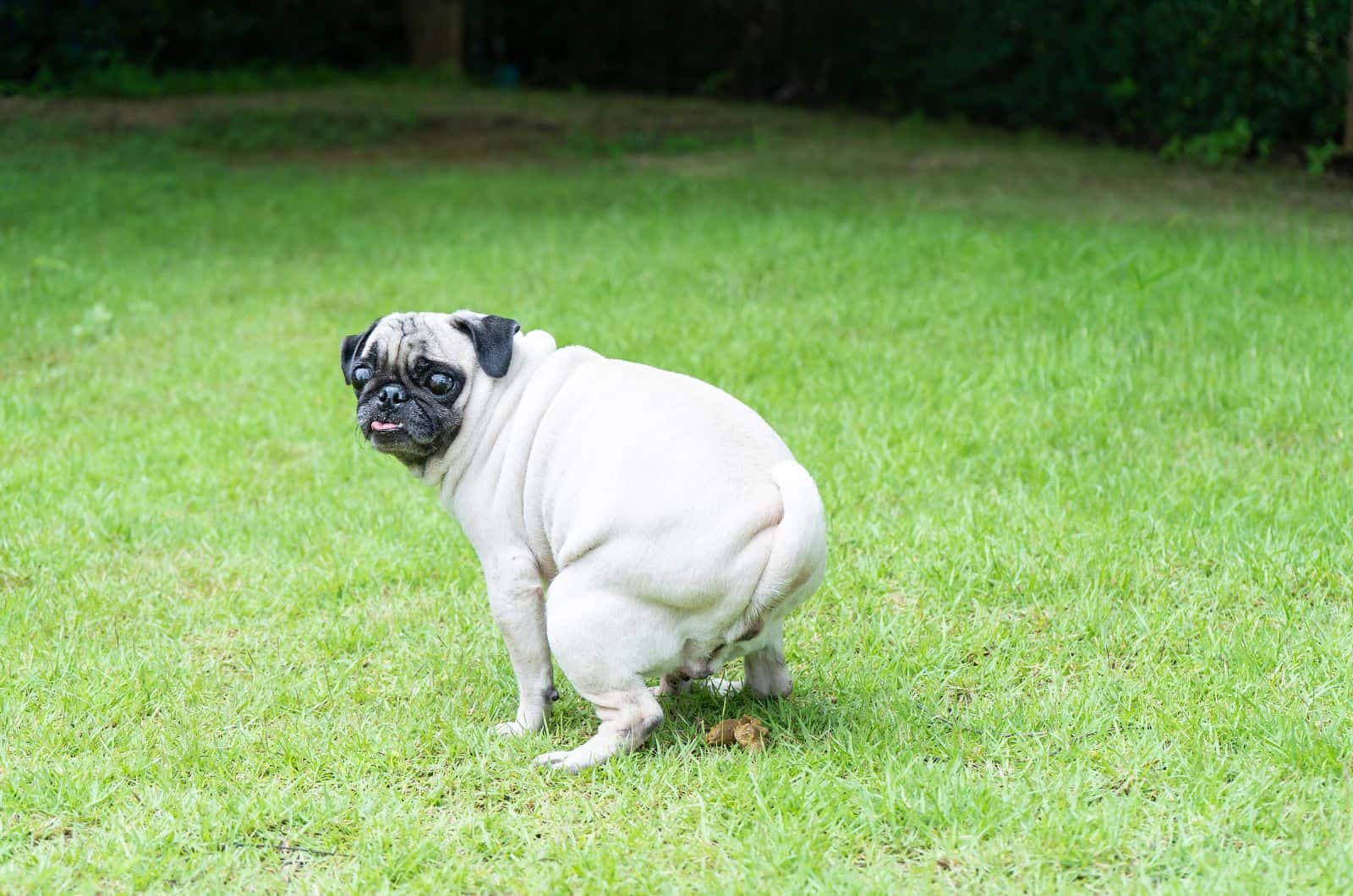
As we previously mentioned, a dog’s poop color tells you a lot of stuff. That is why you should listen to your dog’s poop!
Alright, let’s get into more detail about each dog poop color and its meaning. You might be surprised to realize that something as simple (and as yucky) as dog poop can show so much about the dog’s health.
1. Brown Dog Poop
We will start off with healthy dog poop that is brown in color.
Similar to dog urine color, dog’s poop gets its brown color from the bilirubin pigment. Prior to the creation of bilirubin in your dog’s body, the breakdown of old red blood cells begins. The bilirubin travels to a healthy liver, where it mixes with bile.
The bile then travels into the dog’s stomach, where stomach bacteria take place in transforming the bilirubin into another chemical that’s called stercobilin. So, stercobilin is guilty of coloring your dog’s poop brown!
Only a healthy dog is able to produce healthy brown poop.
Brown dog poop can be lighter and a bit darker in color, but this is completely normal due to dietary changes.
2. Purple Dog Poop
Purple dog poop is in most cases, a reason to visit your vet immediately. Dogs that poop purple colored feces may be suffering from Acute Hemorrhagic Diarrhea Syndrome which is a life-threatening health condition.
This disease is also called Hemorrhagic gastroenteritis (HGE) and it is definitely something that you should not ignore. Besides changes in poop color, a dog suffering from HGE may experience vomiting episodes, runny diarrhea, loss of appetite, and lethargy.
Purple/pink dog poop can also be caused by gastrointestinal infections, tumors, ulcers, intestinal bleeding that is usually in the small intestine.
Although rare, purple/pink dog poop may be caused by dietary supplements or for example, when your dog eats turnips.
3. Blue Dog Poop
Say what? How can my dog’s poop be blue? Could blue poop be the result of my dog eating blue cheese? Well, your dog definitely ate something and it is most likely a foreign object, or worse — rat poison.
Okay, don’t panic. Firstly, collect a stool sample from your dog and call your veterinarian explaining what just happened. You will want to recall where you’ve been with your dog and what he might have eaten.
Dogs are curious and may eat whatever they find interesting. Irresponsible people might place rat poison in wrong places where other people’s dogs can get to it.
If rat poison is the cause of your dog’s poop turning blue, then you should not wait a second longer. Take your pooch to the vet immediately so it can get proper medical treatment.
Rat poisoning in dogs can lead to sudden death and it should be treated as an emergency.
4. Green Dog Poop
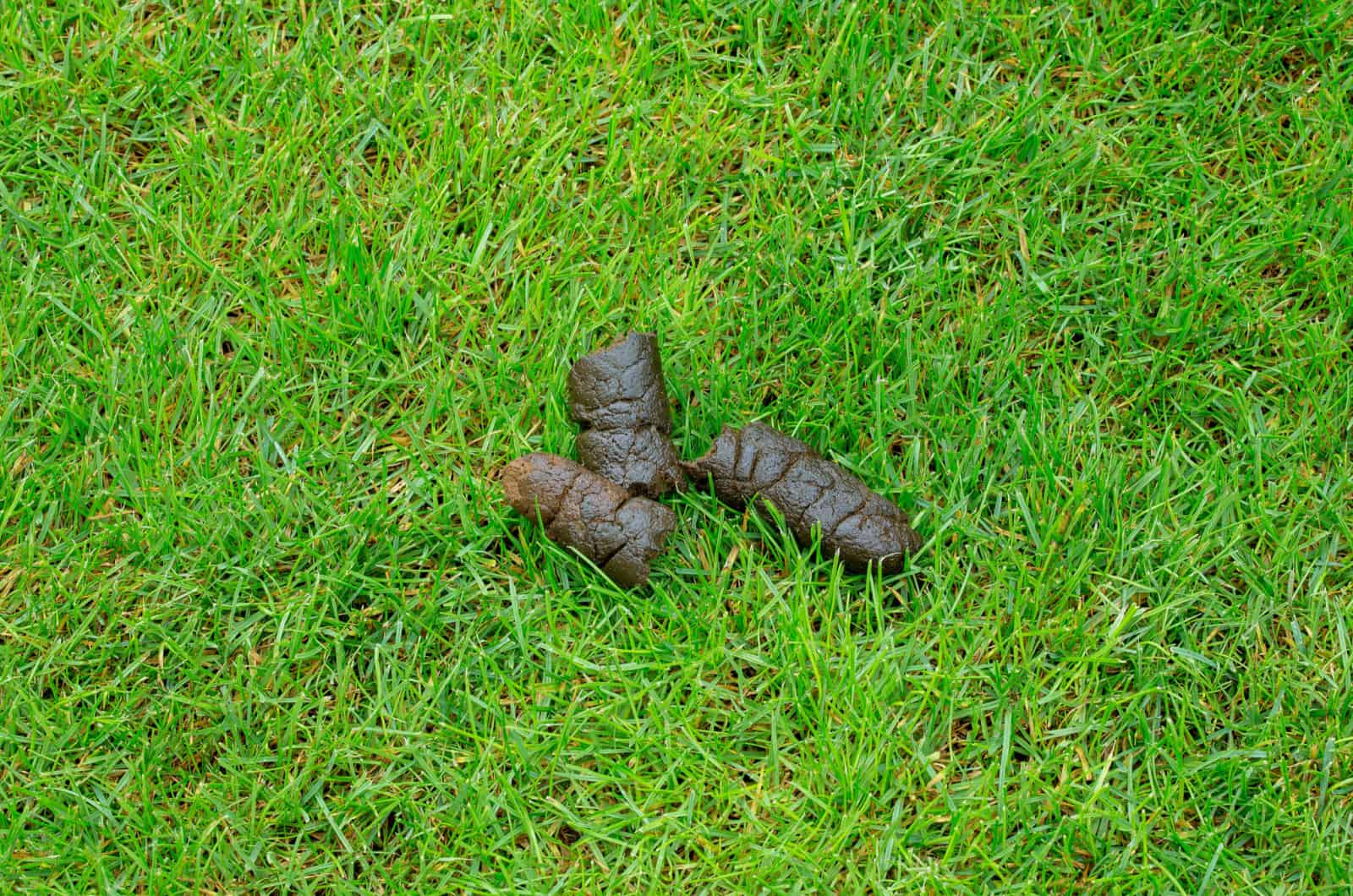
Let’s move on to green dog poop that is in most cases considered normal. Green dog poop may be a sign that your dog ingested food (mostly plants) of similar color.
If your dog’s diet consists of brussels sprouts, salad, green beans, and broccoli, there is a high chance that its poo is going to be green. Same goes for pooches that love to munch on grass!
However, green dog poop can be a result of something more serious than just a plain diet. For example, dogs that are known to have gallbladder issues usually have green colored poop.
Other than that, possible causes of green poop in dogs are intestinal parasites, inflammatory bowel disease, and rat poison ingestion.
Make sure to pay attention to how your dog’s behaving, and try to remember whether or not it had eaten some greens that day.
If you notice any changes in your dog’s behavior or symptoms such as fever and vomiting after it has pooped green, contact your veterinarian immediately.
5. Yellow Dog Poop
If you are a dog owner, then you have probably noticed your dog pooping yellow feces at some point. Yellow dog poop is not a rare sight, and it may not necessarily mean that something’s bad with your dog’s health.
Therefore, yellow dog feces is typically one of the least alarming colors.
Yellow dog poop usually indicates that your dog is intolerant to some kind of dog food. That being said, yellow feces in dogs can appear during transition between different brands and types of dog food (changing dry kibble for canned dog food).
Alongside poop color, your dog may experience yellow loose stools or diarrhea. If your dog poops frequently, chances are that it’s suffering from an upset stomach that is causing it to poop loose stools.
Yellow poop in overall healthy dogs usually doesn’t last more than two days and it can be cured with a change in diet.
However, if yellow dog poop persists, it’s time to call your veterinarian to remove suspicion that your dog is suffering from pancreas, gallbladder or liver issues.
6. Orange Dog Poop
Similar to yellow, orange dog poop often shows signs of food intolerance. Only this time, the food that your dog has eaten travels faster through its GI tract, leaving no time for bile to color it in a healthy brown color.
If orange dog poop is persistent, this might mean that your dog’s liver or biliary duct is not working properly. It’s best to inform your veterinarian about your dog’s orange feces.
Besides orange poop, bad dog breath could be a sign of liver issues and kidney disease.
7. Red Dog Poop
More often than not, red dog poop is a red flag for dog owners. Pooping red is by no means normal in any species, including our beloved canines.
What is colored red in a dog’s body? Blood, of course!
Red dog poop indicates signs of undigested blood. Your dog’s poop doesn’t have to be colored completely in red, it may also be a healthy brown color with red streaks.
Due to the fact that it is undigested, it might mean that your dog is suffering from anus injury that can leave open cuts and wounds. Another thing to take into consideration to why your dog poop is red in color is anal gland infection.
Moving on from your dog’s bum to intestines. Red dog poop can be due to bleeding in the large intestine. Bleeding can also affect small intestines and the whole gastrointestinal tract.
Bleeding from injuries is far less serious than tumors that may develop anywhere within your dog’s body. Tumors may also cause your dog to poop red feces, as well as change its urine to an abnormal color.
So, make sure to take your dog to the vet as soon as you notice red feces.
8. Black Dog Poop
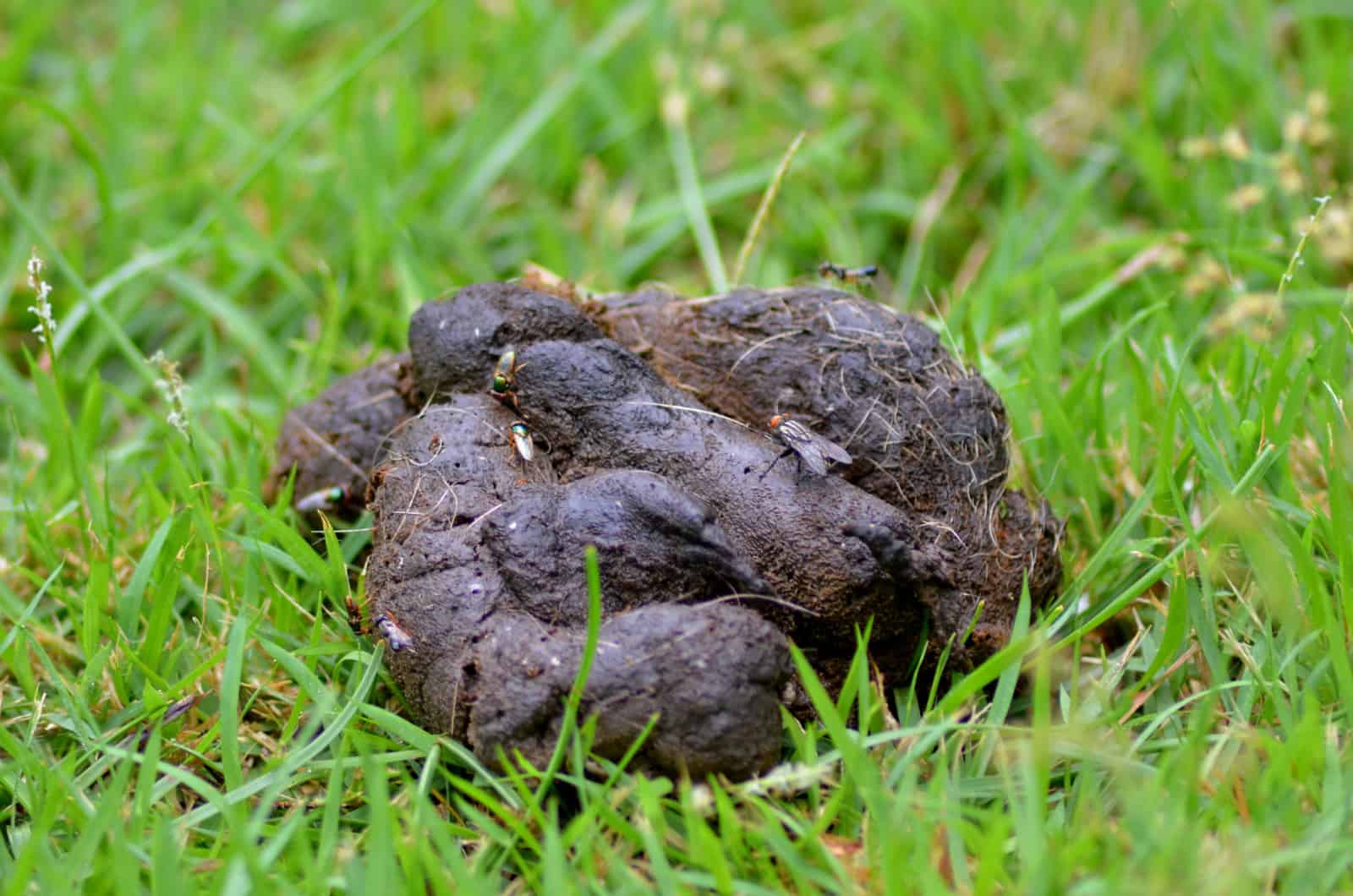
Why is my dog pooping black? Is it black poop or dark brown?
Whether it is dark brown or black, dark colored dog poop is a huge warning sign.
Black dog poop = digested blood. In other words, black dog poop could indicate internal bleeding.
This could mean that a dog that’s pooping dark feces has stomach or intestine ulcers. It could also mean that internal bleeding is coming from other organs but is digested and turned into black dog poop.
Darker dog poop could indicate that your dog has eaten raw food and therefore consumed fresh blood. But in this case, it is usually a darker brown color rather than black. Besides food, dogs that accidentally ingest rat poison or aspirin may have darker stools.
Pay closer attention to your dog’s poop. Give your veterinarian a call as soon as you notice black dog poop, especially if it is followed by frequent vomiting episodes and weight loss.
9. Gray Dog Poop
Gray dog poop is followed by a greasy film on top of it. This means that your dog’s digestion is slowed down or its body is having a tough time breaking down fats.
Gray dog poop can also happen as a result of eating too many fatty foods or as a result of a larger, more complicated problem with their pancreas.
If the greasy gray dog poop appears in large but soft piles, it may indicate Exocrine Pancreatic Insufficiency (EPI).
Treating EPI in dogs is possible but only if the treatment starts on time. If you happen to notice that your dog’s poop is gray, and you can’t recall it eating anything greasy, call your veterinarian to figure out what to do next.
10. White Dog Poop
When dog feces is light gray, white, or pale, then there is something wrong with your dog’s digestive health. White feces are the outcome if the gallbladder or liver are not releasing bile into the intestines to combine with meals. So, it can indicate gallbladder or liver issues.
Another reason why your dog’s poop might be pale or white is due to a diet that is rich in calcium.
Dogs that are often fed with a lot of bones frequently pass out white feces. For dogs, excessive calcium-related white poop is typically not a cause for alarm, although it can lead to constipation. Your dog may fart a lot due to its upset stomach and constipation.
11. Dog Poop With White Specks
If your dog’s healthy brown poop is filled with numerous white spots that resemble tiny grains of rice, then you can be pretty sure that these white spots are tapeworm body segments (proglottids).
In addition to having white specks, your dog’s poop may also be grainy.
When you take a closer look at your dog’s white speckled poo, you may even notice that the tapeworm segments are moving! Eew!
Dogs with white specks in their poop aren’t suffering from major health problems like tumors or organ dysfunctions. But, they are suffering from a severe parasitic infestation. If left untreated, tapeworm infestation can lead to various health problems such as anemia, constipation, and weight loss.
In this case, collect your dog’s stool sample so your vet can give you the right diagnosis. Keep in mind that not all deworming treatments are going to work against tapeworms, so it’s better to ask your vet for advice on an effective tapeworm treatment.
See Also: 6 Home Remedies For Dog Constipation That Really Help
Things You May Find In Dog Poop
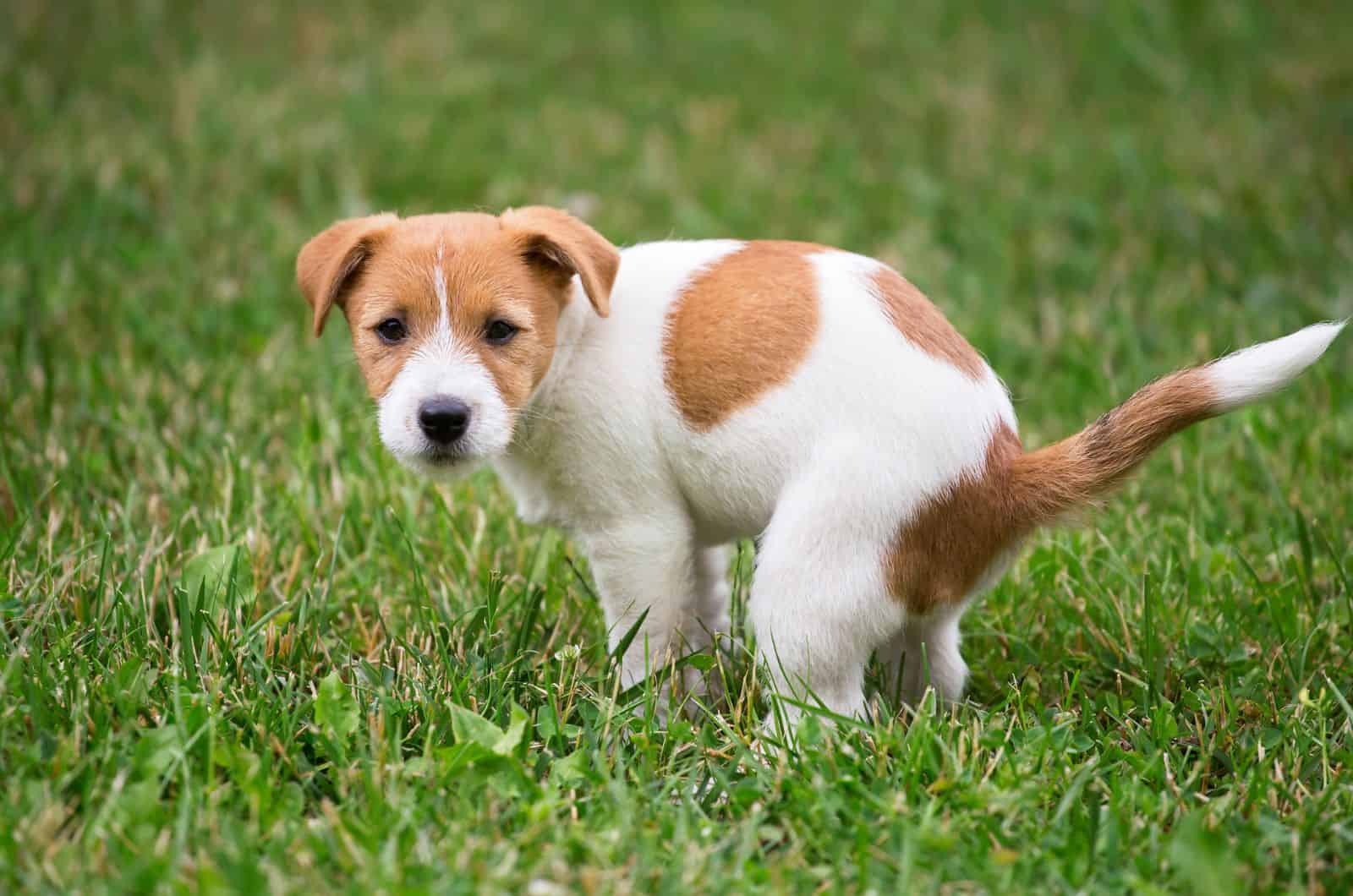
Dogs are curious creatures that like to taste the world around them. By that I mean they love munching on odd things that shouldn’t be in their diet. For example, some dogs like socks, while others treat themselves to some Coeur à la poo (cat poop seems to be their favorite).
Whether you like it or not, your dog will occasionally nibble on something that might get into its stomach just to be passed out in poo.
Here’s what you may find in your dog poo:
1. Hair
2. Foreign objects
3. Plants
4. Undigested food
Ingestion of feces and foreign objects in dogs can lead to various health problems, so it’s best to monitor your puppy during playtime.
When Should I Be Concerned About Dog Poop?
Now that you know how to distinguish healthy dog poop from unhealthy, you already know the answer to this question.
You should be concerned if your dog poop color is abnormal: purple, pink, red, or black. Most of the time, other dog poop colors turn back to normal within two to three days.
You should also be concerned if an abnormal dog poop color persists for a couple of days and your dog changes its behavior.
Alongside the change in dog poop color, pay attention to symptoms such as weight loss, lethargy, heavy diarrhea, loss of appetite and fever.
What Should I Do When My Dog’s Poop Changes Color?
It is your dooty to inform your veterinarian about any changes in your dog’s poop color. If you notice something unusual, collect a stool sample from your dog and take it to the veterinary clinic for examination.
You should also keep track of what your dog eats because you will know whether or not it is time to be concerned about the change in poop color.
If you notice that your dog poop color changed after you have introduced it to new food, make sure to switch to another diet.
Conclusion
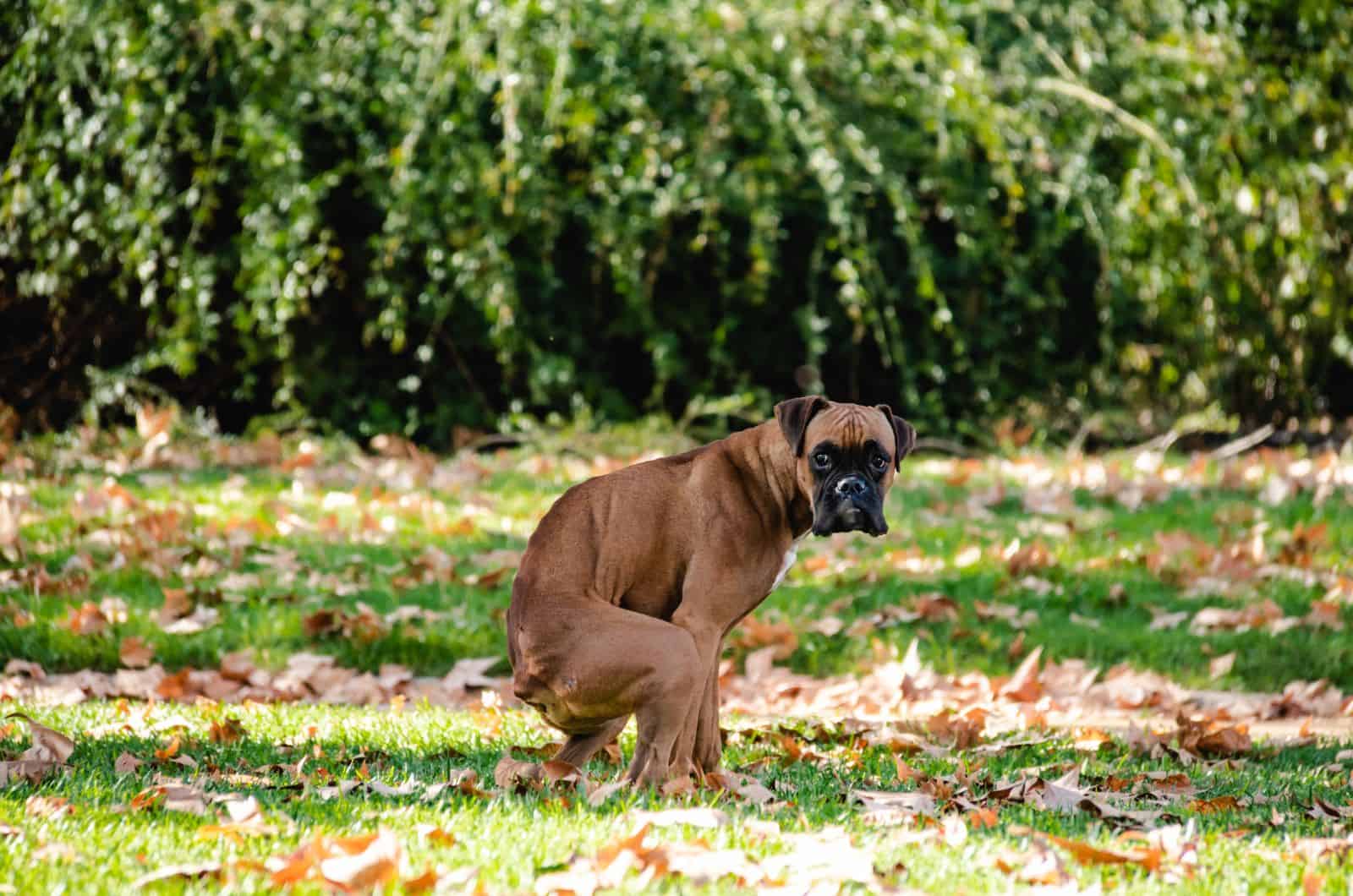
This dog poop color chart shows how important it is for your dog’s health to keep track of its poop. It may sound silly, but taking a closer look at your dog’s feces may save your dog’s life!
Knowing the color of your dog’s poop is essential for identification of underlying health problems. Correct interpretation of the dog poop color chart can help you and your vet to discover problems or triggers before they become severe.
Next time your dog poops, inspect its poo for any color changes or foreign objects!
Related Content
Dog Urine Color Chart: What Does My Dog’s Pee Color Mean?
Dog Earwax Color Chart: Everything You Need To Know
Dog Tail Position Chart: A Simple Guide To Your Dog’s Body Language
